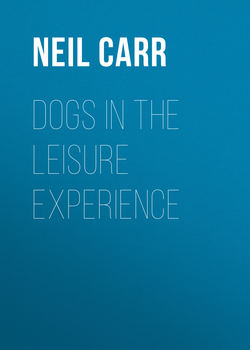Читать книгу Dogs in the Leisure Experience - Neil Carr - Страница 9
На сайте Литреса книга снята с продажи.
1 Introduction Why a Book on Dogs in Leisure?
ОглавлениеThe dog, Canis familiaris, has played and continues to play an integral role in the lives of many individual humans and societies throughout the world. This has been an evolving relationship since at least the Neolithic era (Herzog, 2010; Bradshaw, 2011; Power, 2012), with dogs being defined as the first domesticated animal (King et al., 2009; Holmberg, 2013). These first dogs are actually more accurately defined as wolves. While debate continues about the exact time of the split between the wolves and dogs, according to Bensky et al. (2013) it began approximately 100,000 years ago. Today, there is a huge array of types of dogs yet they all have one thing in common: their relation with humans. The willingness of the wolf to share its space and time with early humans has been identified as a central reason for the evolution of the dog and this willingness is clear today in virtually all dogs, be they pets or working animals. It is the closeness between dogs and humans in general, and particularly between me and my dogs, that is the driving force behind this book.
Despite the apparent closeness between humans and dogs, it is clear that this relationship and indeed the dogs themselves have existed at best at the margins of academic interest and research (Budiansky, 2000; Coppinger and Coppinger, 2001; Wise, 2002; Csanyi, 2005). This view is supported by Westgarth et al. (2010: 38) who stated: ‘It is surprising how little we know about the domestic dog’. More generally, as Herzog (2010: 16) pointed out: ‘the study of our interactions with other species has, until recently, been neglected by scientists’. This does not mean we have not studied animals as objects, far from it, but that we have not focused significant attention, especially traditionally, on researching them from a perspective that sees them as sentient beings. The sentience of dogs is an issue that will be explored in detail in this chapter and referred to again elsewhere in the book.
As changes have occurred in academia and we have witnessed the development of understandings of animals as more than mere objects, there has arguably been a focus, as so often in research, on the exotic. Academics by and large seem to have, just like the general populace, an obsessive interest in the exotic, whereas interest in the everyday, the mundane, tends to be limited. It is into this latter category that the most popular pets, including the dog, fit. Indeed, McConnell (2005: xxvi) has stated that dogs have: ‘been proof for decades of the saying “Familiarity breeds contempt”. Scientists could study right whales or Serengeti lions or scissor-tailed flycatchers, but heaven forbid you tried to make your name as a researcher studying dogs.’ Yet, as McConnell (2005) noted, this situation is changing. Indeed, Hare and Woods (2013: 125) have noted that: ‘From being thought of as an unremarkable animal made stupid by domestication, all of a sudden dogs have become one of the most popular species for animal researchers to study.’
The field of leisure studies, as broadly defined, has similarly tended to ignore pets in general (Norris et al., 1999) and dogs in particular, focusing instead on the more exotic, wild animals in the tourism context (e.g. Coghlan and Prideaux, 2008; Markwell and Cushing, 2009; Duffy, 2014). Limited number of studies that have examined dogs in leisure have tended to focus on dog sports such as flyball and agility (Gillespie et al., 1996), as discussed in Chapter 3. Yet, while they are focused on a dog-related activity, the attention in most of these works has been on humans (e.g. Kemp, 1999; Baldwin and Norris, 1999; Gillespie et al., 2002; Hultsman, 2013). In contrast, the limited work undertaken in the veterinary sciences field on dogs in sport has focused exclusively on the mechanics of the animal (Pfau et al., 2011; Payne, 2013a, b; Birch and Leśniak, 2013), ignoring in the process the role of humans and the social construction of these dogs and the sport in which they are involved. This view is supported by Atkinson and Young (2005), who identified a lack of research by sociologists into blood sports in general and the sport of greyhound racing in particular. As will be discussed throughout the book other works, though small in number, have looked at dogs in a variety of settings but have generally failed to do so through a leisure studies lens, despite the activities the dogs and their owners are engaged in being clearly identifiable as leisure. More often than not they have focused on humans rather than the dogs. Even where attempts have been made to look at the dog and human as subjects, the data have tended to stem exclusively from the latter group (e.g. Kuhl, 2011), in the process arguably devaluing the voice of the dog.
